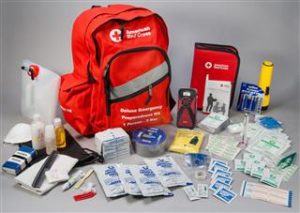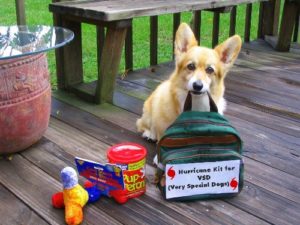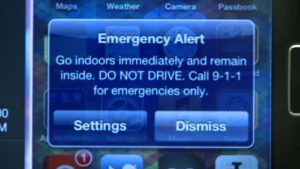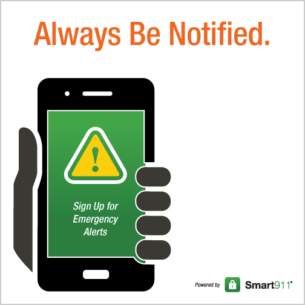Plan & Prepare
Step 1: Get a Kit
 Make a kit of emergency supplies
Make a kit of emergency supplies
Items For Your Home:
- Three days’ supply of canned, non-perishable, ready-to-eat FOOD
- Three days’ supply of WATER (a total of three gallons per family member)
- Battery-operated RADIO and extra batteries
- FLASHLIGHT and extra batteries
- One week’s prescription MEDICATIONS
- FIRST AID KIT
- Personal TOILETRIES
- Non-electric CAN OPENER and UTENSILS
- SPECIAL NEEDS items:
- INFANT care items
- Items for ELDERLY family members
- Items for relatives with DISABILITIES
- CASH or TRAVELERS CHECKS
- Store important DOCUMENTS in a waterproof, safe location
In Case You Need To Evacuate:
- Keep your vehicle’s gas level at a minimum of half-a-tank.
- Every family member must carry CONTACT INFORMATION:
- All phone numbers at work, school, etc. for every family member
- The name and number of a relative who lives out-of-state, to call in case your family gets separated.
These are the basics. Once you’ve created your basic kit, you should continually expand and refine it. For example, you could follow these additional tips on emergency food and water supplies.
Step 2: Make a Plan
“Make a Plan” for Yourself, Your Family, or Your Business
 Establish a predetermined meeting place away from your home. Having a pre-arranged place to meet can save time and minimize confusion should your home be affected or the area evacuated. This may even be the home of a friend or relative.
Establish a predetermined meeting place away from your home. Having a pre-arranged place to meet can save time and minimize confusion should your home be affected or the area evacuated. This may even be the home of a friend or relative.
Choose an out-of-state contact your family members will call or email to check on each other, should a disaster occur. Make sure every family member has that person’s contact information.
Collect contact information for your family:
- phone (work, cell, office)
- social media
- medical facilities, doctors, service providers
- school
- Complete a contact card for each family member. Everyone should keep these cards with them at all times.
- Make sure all your family members know how to text. Make sure everyone knows how to turn on a cell phone, find the text messaging app, type a message, and send it to a contact.
Find the safe spots in your home for each type of disaster. For example, during a tornado, you would need to seek shelter in a lower level room without windows.
PRACTICE. Review these plans with all members of your family. Practice your disaster plans by running drills with the whole family.
Learn how and when to turn off the water, gas, and electricity at the main shut-off locations.
Show each family member how to use a fire extinguisher, and show them where it’s kept.
If you have Disabilities or other Special Needs:
- More information for people with disabilities, older adults, caregivers and people with access and functional needs
- Register with Register Ready and document the assistance you might need during an evacuation or other emergency.
If you have Pets:
 Read these Preparedness Tips for Your Pet. Disaster shelters cannot accept pets other than ADA assistance animals. You must plan accordingly.
Read these Preparedness Tips for Your Pet. Disaster shelters cannot accept pets other than ADA assistance animals. You must plan accordingly.
Learn what it means when Public Safety Officials order you to:
Learn More
Visit the American Red Cross Make a Disaster Preparedness Plan web page for more information and in multiple languages.
Step 3: Stay Informed
 It is important to know about the risks that may happen in your community, and to know whether an emergency is imminent or is already taking place.
It is important to know about the risks that may happen in your community, and to know whether an emergency is imminent or is already taking place.
Visit our Community Alerts page to learn about the different ways emergency officials provide information during times of emergency.
Homeland Security Alerts
Latest Facebook Posts
2 days ago
1 week ago
4 weeks ago


